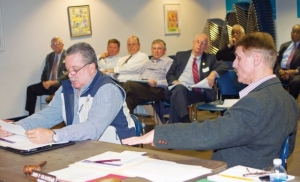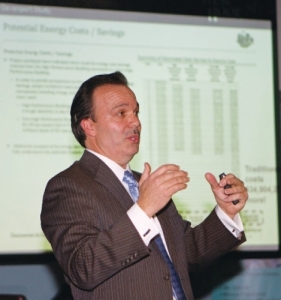School board approves $40 million for new schools
By Steve Herring
Published in News on February 16, 2014 1:50 AM

News-Argus/STEVE HERRING
Wayne County Board of Education chairman John Grantham, right, speaks to the members of the Board of Commissioners, who attended a Friday afternoon meeting of the school board as school officials discussed plans for school facilities' projects.

News-Argus/STEVE HERRING
Architect Robert Ferris, CEO and president of SfL+a, reviews the proposal and the potential in energy savings with the school board as they discuss possibilities for the proposed schools.
The Wayne County Board of Education is proceeding with a $40 million plan to build high-performance (energy efficient) middle schools in the Grantham and Spring Creek communities through a lease-purchase agreement with a developer.
The school board would make a down payment of $5 million and would pay the annual $3.2 million payment from existing sales tax and lottery reserves.
While some parts of the plan might have to be scaled back to stay within budget, school board members said Friday they would not cut out auditoriums, which they say can be athletic and cultural centers in a community.
The board voted 5-0 following a three-hour special session to ask the Wayne County Board of Commissioners to endorse the project even though commissioners had called for a $30 million project using design/build to construct two traditional schools.
School board members Thelma Smith and Dwight Cannon did not attend the meeting.
School board members want commissioners to act quickly in endorsing the plan to meet a timetable to get the financing request to the Local Government Commission for approval in April. The quick action is needed so the process can get under way to have the schools ready to open in August 2015.
However, commissioners won't be surprised when they are asked to add the request to their agenda -- all seven commissioners, who were wearing visitor tags, attended the meeting.
An attorney for the N.C. Press Association said commissioners violated the state's Open Meetings Law by not calling their own special session to be part of the meeting.
"The commissioners should have followed the Open Meetings Law protocol," attorney Amanda Martin said. "The only exception to when they can all be together but not follow its requirements is when they meet for purely social reasons.
"It doesn't matter that they didn't take any votes, etc. They were there 'on official business,' which is enough to trigger the Open Meetings Law requirements."
Commissioners asked questions as architect Robert Ferris, CEO and president of SfL+a, reviewed the proposal and $4.5 million in cost-saving options with the school board. It is possible some of the cuts could be added back into the project depending on final interest rates and construction costs, he said.
Several commissioners questioned how lease-purchase works, why the plan did not utilize design/build and how high-performance schools worked.
Commissioner Steve Keen asked Ferris how the value of the school would be computed in 20 years when it came time for the county to purchase the lease.
"The way this is currently structured, you would have the option to buy after five years," Ferris said. "We fully anticipate you assuming our loan after five years and you would basically buy it for what we owe on it.
"I don't know where that notion comes from that I would lease the building to you for 20 years then sell it back to you for $20 million. We are going to lease it to you for five years. We are going to operate it for five years. We are going to optimize all of the systems over five years and then you are going to basically assume the loan."
Ferris said his company would make a development fee of about $400,000 per school upfront, but would not make any money on the lease payment from the schools since it is the same as the debt payment.
As the developer, Ferris said there are two financing options -- one is selling something similar to bonds and the other is private financing through a bank.
Ferris said he prefers the private funding, which could cut another $1.8 million from the final costs.
Design/build is not cost effective for school buildings, Ferris said.
Commissioner Joe Daughtery said that comment seemed to be a matter of opinion since he had spoken to architects and contractors who had told him it did save money.
Daughtery said if design/build saves money, he wanted to explore it. He agreed there is a time factor that might offset some of that savings.
A cheap school can be built, but it will not save the county any money, Ferris said.
Ferris said his company does design/build projects. The process is fine for simple warehouse-type projects, but not for more complex ones such as schools, he said.
Also, design/build might save some time, but not cost, he said.
Ferris argued that in the long run it would be cheaper to build the more expensive high-performance schools than the cheaper traditional models.
The high-performance process allows the projects to get off the ground up to nine months quicker than traditional projects, locking in costs before inflation can force them up, he said.
Also, the schools use solar energy to generate enough electricity to power them and still are able to make money by selling the excess power to electric companies, he said.
In effect, the schools would not have an electric bill, Ferris said.
Over the course of the 40-year life of debt on the school, the savings in electricity costs could be nearly $35 million for the two schools, Ferris said.
School board members also used the meeting as a chance to lobby for auditoriums, something some commissioners have suggested could be eliminated to save money. Another option commissioners have said is a gymatorium or a lunchroom that could double as an auditorium.
Neither combination works well, school board members said.
"I have some heartburn over the payment," Daughtery said.
He said he did not know how to cut costs other than possibly comparing the proposed schools to existing ones that do not have auditoriums.
Ferris said maybe it wasn't so much the payment as commissioners not wanting auditoriums. That is not the case, Daughtery said.
Daughtery said he was looking for a payment below $3 million.
Superintendent Dr. Steven Taylor said the school board had worked "very diligently" to get the payment down.
"If we can make the payment of $3.2 million, including the auditorium, I really don't see what opposition you could have," he said.
School board Chairman John Grantham said it appears that someone has gotten the idea started in the communities that they had to choose between not having an auditorium and not having a school.
"When you put it like that, most anybody would pick a school with no auditorium," Grantham said. "Back in the 1930s when they were building schools, they had auditoriums and they certainly didn't have the money or any better money situation than we have. They realized the importance."
The southern end of the county at Spring Creek and Grantham lacks such facilities, which are "tremendous assets" to the communities, Grantham said.
"We need to bring some balance," he said. "It is almost like we have two counties right now -- we have a north end of the county and a southern end of the county. We need attractive schools there to attract people."
Grantham said he realizes the county has to prioritize and has a limited budget. However he said he had not heard a groundswell of public support for things like a proposed $12 million agriculture center.
Nor, he said, had he heard a "lot of clamor" for spending money on jails.
However, the people are asking for the schools, he said.
School board member Arnold Flowers told Daughtery that they share similar philosophies, and that he would like to see the payment lower as well.
Flowers said that during his life it seems that so much of tax money is spent toward the center of the Goldsboro area. People in Grantham and Seven Springs pay taxes just like others through the county, he said.
For example, look at the new Senior Center, he said.
While it is a fine facility and a much-needed project, Flowers said that as a resident of the Seven Springs community, he could probably not get much use out of the center.
But if the new Spring Creek Middle School had an auditorium, he would go there to watch his grandchildren participate in programs.
Daughtery said including auditorium would establish a precedent and other communities would expect them. Also, the county has to be mindful there are two other new schools proposed in the county's capital improvement plan, he said.
But school board members pointed out that the county had not built any new schools in many years.
Also, the auditoriums add to a community's ability to attract new residents and business, they said.
School board member Chris West said he had spoken with people in the communities and that they are "just ready to move on."
He agreed with Taylor about the payment.
School board members also said that if the auditoriums are not built now that the county would never go back and add them.
Besides, school board member Eddie Radford said, cafeterias "smell like Spaghetti-Os when it comes time to be used as an auditorium and a gym smells like sweat."
